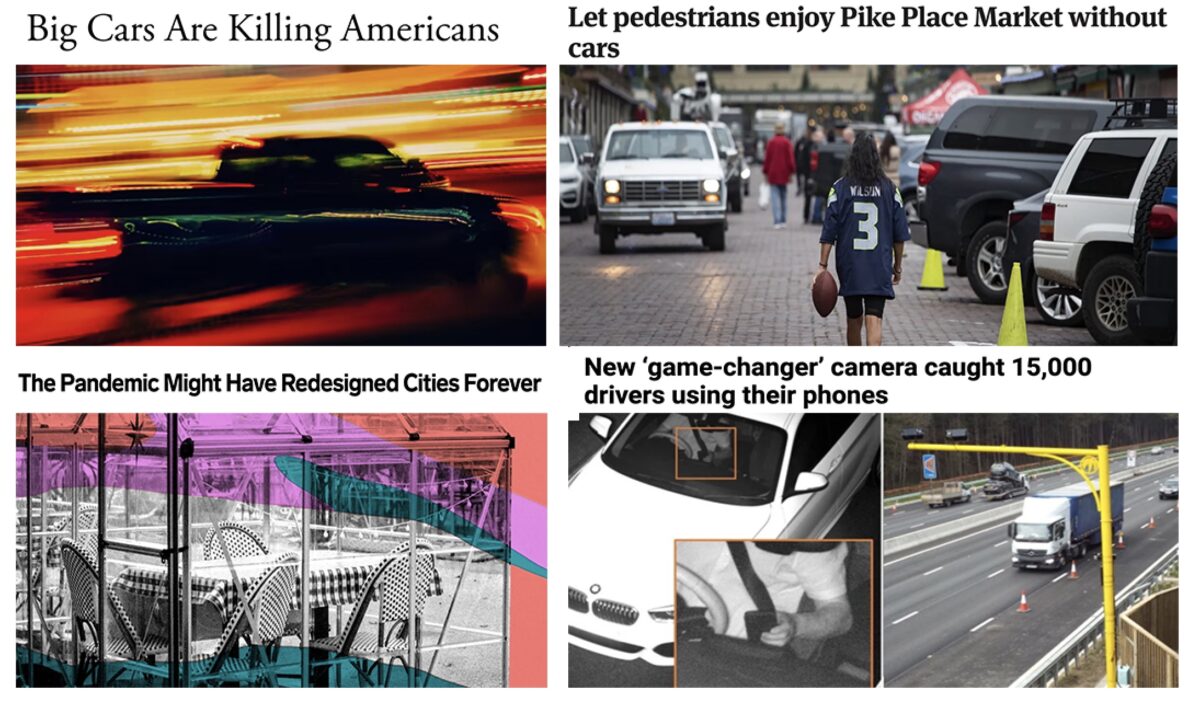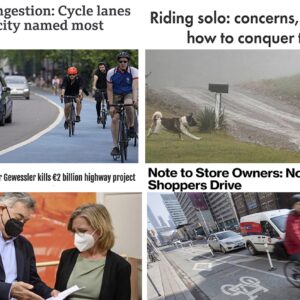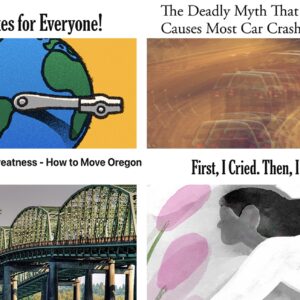Welcome back from the winter break! I hope your New Year is off to a good start, and/or you have made peace with a new definition of “good”.
Here are the most notable items our writers and readers came across in the past seven days…
Strong mayors: The mayor of America’s largest city, Eric Adams, biked to work for his first day in office. And the mayor of the small Bay Area city of Emeryville, California, John Bauters, went viral for a tweet that said he’d remove one on-street parking spot for each complaint he receives from someone who doesn’t want to share the road with bicycle users.
People over cars: The editorial board of the Seattle Times has come out in strong support of an effort to make famous Pike Place Market a carfree zone.
Race and policing: A story by Willamette Week found that a new Portland Police policy to not cite people for low-level traffic infractions has not had an impact on racial disparities.
Big trucks suck: Author Angie Schmitt has a piece in The Atlantic where she makes the case that American automakers (and their customers) are fueling a deadly mega-truck trend and government regulation is the most sensible response.
Advertisement
The French model: Speaking of forcing automakers’ hands, a new law in France will require automakers to include a message in car advertisements that encourages viewers to consider alternatives like biking, walking, and transit.
Honest car commercial: An alternative weekly newspaper in Seattle (inspired by the carfree Pike Place Market idea) says cars are so unhealthy for humans and cities they should be treated like cigarettes when it comes to advertising.
[Get the Monday Roundup delivered to your inbox.]
Don’t Look Up: The satirical Netflix blockbuster captures the frustration of climate change scientists and could help more people open their eyes to the ongoing crisis.
Caught phone-handed: A new traffic camera in use on a trial basis in the UK can reportedly catch drivers using cell phones with much more clarity than anything else on the market.
Great context on Covid’s urbanism impacts: Wired has a very relevant roundup of how pandemic-related culture changes have “shifted people’s perceptions of what a city can be”.
Thanks to everyone who shared links this past week.







Thanks for reading.
BikePortland has served this community with independent community journalism since 2005. We rely on subscriptions from readers like you to survive. Your financial support is vital in keeping this valuable resource alive and well.
Please subscribe today to strengthen and expand our work.
I’m no fan of the mega-trucks, and I’m in favor of regulating their size, but the “reptilian” argument advanced in the Atlantic piece is repulsive.
Do people drive giant pickup trucks because they’re “reptilian”, evil, less-human types, or do they drive them because that’s the product on offer, and the hauling capacity, though in many cases rarely used, sure is useful when you need it?
Also, the claim that “black and indigenous people are disproportionately hit and killed while walking” may be true, but they no evidence is offered that they’re disproportionally killed by mega trucks.
I was at the welding store today. Next to me was a guy in a giant jacked up pickup truck trying to unload his welding gas cylinders so he could exchange them for new ones. His truck bed was so high that it made the task very difficult. If he tried to reach the cylinders from the ground they were too high, and if he tried to lower them down when standing ( or kneeling) in the bed the ground was too far down to be practical. So this completely destroyed ( for me ) the argument that these ridiculous trucks are purchased for hauling capacity and not for reptilian ego needs.
Far as I can tell, the “reptilian” label has nothing to do with anybody being “evil, less-human types” and everything to do with people being creatures of instinct and habit like any other animals. In my opinion, you’ve raised a false dichotomy. People can drive big trucks both to ensure their survival over others in crashes, and because such trucks are on offer and have hauling capacity other vehicles don’t.
Skepticism can be healthy, but maybe you could start investigating that claim by reading the author’s book on the matter. The Atlantic page has links to it before and after the article, and a search engine query would provide links to the same book on other web sites if you’d prefer to look somewhere aside from Amazon.
It speaks poorly of The Atlantic that the claim wasn’t backed up in the article itself. Don’t they editorial policies for that kind of thing?
I agree the article lacking evidence is disappointing. However, the article is also much shorter than most Atlantic articles I’ve seen, so maybe that’s a factor.
A 1995 V6 Ford F-150 weighed 3886 pounds and was 71 inches tall. This is what it looked like
https://bringatrailer.com/listing/1995-ford-f150-36/
The 2022 F-150 on the other hand has a height range of 75.2 – 79 inches and depending on the model can weigh anywhere from 4100 pounds to almost 5000 pounds at its heaviest. This is what it looks like
https://www.motortrend.com/news/2022-ford-f-150-electric-everything-we-know/
You can’t say with a straight face that the 2022 needs to look like this. Nothing about the flat grill and high cab is necessary to haul things around. This truck looks like this because truck owners want to look ‘bad ass’ and it’s a danger to everyone around. Have you ever been in one of these things? The visibility is terrible.
As someone who wants a truck but doesn’t want to drive a tank, I’d love it if they made actually practical trucks like the old Tacomas and Rangers, or even the old F-150s and T100
I’ve never been in one and I don’t think they need to or should be this tall. I just don’t think ascribing personality and moral characteristics to people based on the consumer products they own is a particularly useful pastime.
I disagree and the marketers at Ford/Tesla/Toyota/Chevy all disagree too. These trucks are designed to appeal to certain personality type who wants their truck to say “I’m masculine”. I don’t think it’s a stretch that the type of people who define their masculinity through driving a monster truck frequently have other personality problems. These car companies are just using toxic masculinity to sell vehicles. I promise that Ford’s customer profile for the massive F-150 lightening is basically a profile of a toxic man.
https://en.wikipedia.org/wiki/Toxic_masculinity#:~:text=In%20the%20social%20sciences,%20toxic,to%20certain%20traditional%20masculine%20ideal
Sure, some people just need/want a truck and basically all options at this point are monster trucks, but the race to build trucks to be bigger, more aggressive, and deadlier is just a race to win over a group of men who are self-possessed, vain, and have a need to define their masculinity through their possessions.
You can say that about any of the auto subcultures — classic cars, tricked-out Hondas, low-riders, Teslas, van-life folks, 2000-era Japanese cars, Subarus, etc. I mean maybe, but probably not really. It’s mostly just stereotyping.
And if it works there, it probably works with bicycling niches as well. Which is also just stereotyping.
But it’s not just stereotyping. Vehicles–and the marketing used to sell them–are created to appeal to specific segments of consumers. You can create accurate profiles of characteristics of people who buy any particular type of vehicle (with the understanding not every characteristic applies to each individual buyer) just as you can with people who consume television programming, or postings on social media, or bicycles.
BikePortland in the past has linked to studies showing how true some “stereotypes” of vehicle drivers are (BMW drivers really are more aggressive, etc.).
It’s one thing to say that we’ll market our cars to people males who think they need to do lots of off-road driving. That’s not stereotyping. Saying that people who drive Jeeps exhibit toxic masculinity is.
All stereotypes have some truth to them, that’s why they exist. It doesn’t make them less odious.
I think you perceive a more broad stroke in cmh89’s comment than is evident, because they never said anything that states or implies all people (or even a majority of them) who drive the large trucks exhibit or consist of toxic masculinity.
Seems a bit dismissive. Whether it’s “just stereotyping” or not, obviously encouraging one subculture is different from encouraging others. In this case, one happens to pose greater threat to pedestrians, etc.
It seems to me that you buy into that stuff as much as some dude who thinks driving a big truck makes him a cowboy.
The fixation on trucks as opposed to the SUVs that most liberals/progressives drive is noted.
Why didn’t you compare the 1995 single cab to a 2022 single cab, they look incredibly similar and the 2022 weighs 4,069 lbs? Despite being 300 lbs more, the 0-60 stopping distance went from 160 feet in 1997 to 119 feet today, that is quite the increase in stopping prowess for a base model vehicle. Of course, none of these hyperbolic, toxic masculinity nonsense statements remotely approach the other technology inside these vehicles that notify of approaching cross traffic, pedestrians, or even bushes. I don’t have one of these, or the need for one, but the suggestion that these vehicles are just death machines is ridiculous.
This kind of hopium is one of the reasons that urban residents shy away from the radical transformations needed to genuinely address transportation-associated emissions.
Actual data (as opposed to cult-like motivated-thinking) shows that USAnian transportation gasoline emissions were slightly higher in the second half of 2021 than they were in 2019. And this is with most middle/higher-income people “working from home”. What do the fantasists at wired believe will happen when more of the “working from home” elite start commuting to their jobs?

You don’t need a fancy camera in the sky. Anyone sitting on a Trimet bus can spot drivers using their phones while driving. Often.
“Shocking findings from the trial”
Yeah, “shocking” is the wrong use of this word because anyone standing on a streetcorner looking in car windows knows this is standard driver behavior and should be expected.
Seeing someone being pulled over and ticketed for texting while driving, now that would be truly “shocking”.
As for “don’t look up”. The difference between a comet and climate change couldn’t be more stark. Whether 2 objects in motion are going to collide or not is relatively easy to calculate by well established laws of physics.
What the average Earth surface temperature will be on Jan 1, 2122 is a problem with many, many more inputs.
I’d agree that’s relevant if I thought that, given compelling evidence of a problem, people will rally to focus on a solution. But too many people don’t. They behave in the selfish, denying, distracted ways people in the movie behaved.
Your “selfish, denying, [and] distracted” is somebody else’s “not very compelling”.
Yes, that’s my point. That’s why I don’t think the fact that the movie is about a comet instead of climate change diminishes the movie’s message.
In fact, it makes it more powerful. The inability of people in the movie to focus on a solution to the very obvious problem of the comet is entirely believable. So when the the problem is something more complicated–climate change instead of a comet–the odds of people being able to focus on a solution are even bleaker.
Your logic seems backwards to me. The entirely fictional dumb response to the simpler comet scenario is more “believable” than the fact that people remain un-convinced by “climate change”, with its murkier evidence? Even less clear is the idea that any intervention we might make will be effective. Hell for all we know, much like the covid lockdowns, the proposed interventions might cause tremendous human suffering while being completely ineffective at fighting climate change.
The fictional response in the movie doesn’t ring true either. NASA is already experimenting with comet defense tactics even when there is no known immediate threat.
Would you say that a giant comet strike is a bad analogy for climate change? I agree. One causes extinction of almost all life, while the other merely wipes out the homes and livelihood of nations or species born in the wrong place.
Should I be more concerned about old people who can’t take the heat now or about what their grandchildren will experience at the end of this century?
Given that lots of folks seem to enjoy disputing established facts, I’d say there’s little hope we can even agree on what the surface temperature of the earth was on Jan. 1, 2022.
(Also Upton Sinclair’s quip that “It is difficult to get a man to understand something, when his salary depends upon his not understanding it” comes to mind.)
Anthropogenic radiative forcing is also very easy to calculate by well-established physics. In fact, crude models used in the 1980s predicted the current ~2.2 F in global heating very well indeed.
However, I’m fairly sure that USAnian individualism and its cognitive dissonance will suppress any feelings of empathy for young people in your family or elsewhere that the success of climate modeling might evoke. After all, FYIGM is the bedrock of USAnian culture.
So you’re putting the predictive powers of “Anthropogenic Radiative Forcing” up there with the laws of newtonian mechanics? Mkay.
If you had paid attention in your high-school science classes you might have remembered that Newtonian mechanics have already been shown to be incomplete at the molecular level (quantum mechanics), relativistic level, and the macro level (e.g. non-newtonian fluid dynamics).
I guess my previous comment was blocked for being too snarky. Sigh… so you’re arguing against the laws of classical physics? Smugly, no less?
I believe you can levitate Soren! It’s only the “laws” of old white men that are keeping you down, glued to the earth like a slave. Why don’t you jump off a bridge and set yourself free?
I see you haven’t really addressed soren’s claim that “Anthropogenic radiative forcing is also very easy to calculate by well-established physics.” Do you disagree with that claim, and if so, why?
Well because “very easy” is in the eye of the beholder isn’t it? “Very easy” compared to calculating whether objects moving through space are on a path to collide?
I agree that if you had a simplified model that was something like a fish tank with a heat lamp, you could probably calculate the radiative forcing for that model “very easily”, but I do not think that computer models which claim to capture, simulate, and predict the future behavior of the entire earth’s ecosystem are that clean.
As for Soren’s claim of predictions from the 80s proving accurate today, yeah I’m skeptical of that too. I suspect it’s a bit of cherry picking from dozens if not hundreds of predictions. Having one pellet from a shotgun blast hit doesn’t make you a sharpshooter.
Equations used to estimate changes in temperature examined changes in CO2 levels in a one layer equilibrium model:

For example, Hansen et al in 1981:

Subsequent models are discussed here:
https://www.carbonbrief.org/analysis-how-well-have-climate-models-projected-global-warming
Hansen’s original paper: https://pubs.giss.nasa.gov/docs/1981/1981_Hansen_ha04600x.pdf
Clem, I saw the movie at this year’s start. I saw it only because my brother followed an acquaintance’s recommendation, and I expected to hate it, but I didn’t. Since seeing your comment, I’ve tried to think of easy ways to make clear you have a misunderstanding of the movie, because it’s not really about whether anthropogenic climate change is credible, but I’ve had little time to focus on that endeavor. Fortunately, I just read a Current Affairs review which says everything (and more) I’d have liked to have told you. I hope you will read it: https://www.currentaffairs.org/2021/12/critics-of-dont-look-up-are-missing-the-entire-point
Mega trucks aren’t the problem. Average Americans driving vehicles far larger than their genuine needs are. But what did you expect with Republicans refusing to approve higher gas taxes, thereby keeping gas cheap, cheap, cheap!
…in many cases that results in people driving “mega trucks”, so saying they aren’t “the problem” (as if only one problem exists) is not helpful. I’m with you in opposing the GOP, though.
Don’t forget low interest rates, a bipartisan project since 2009. Our economic policy has been to keep the throttle wide open with interesting effects like increased sales of large vehicles and a lot of development inside and around I-405. Now inflation fears may be flipping the script, so we’ll no doubt do the other thing for 10 years past its pull date.
Great… more politics of pettiness. Remove parking if it makes sense, don’t if it doesn’t. This sort of tribalistic retaliatory posturing really turns me off.
In the Church of Shoup all parking is sinful (and especially the parking that has reduced VMT in SUV/truck/car-centric hells like the Netherlands — the dreaded park and ride).
What if instead of just linking to the WW article on race and policing and concluding, “that a new Portland Police policy to not cite people for low-level traffic infractions has not had an impact on racial disparities”, someone on the ever increasing staff at BP did some analysis, because we know the WW won’t.
The first quarterly reduction resulted in a 3.2% quarter over quarter reduction, the second quarter is 4.3% (quarter over quarter). Annualized, this is a 15% reduction in stops of POC, relative to the proportion of whites staying the same, its almost like this is working. Imagine if PPS increased the graduation rate for POC by 15% in a year, or if PBOT increased bike lanes in East Portland by 15% in a year, this blog would not be concluding that nothing had changed.